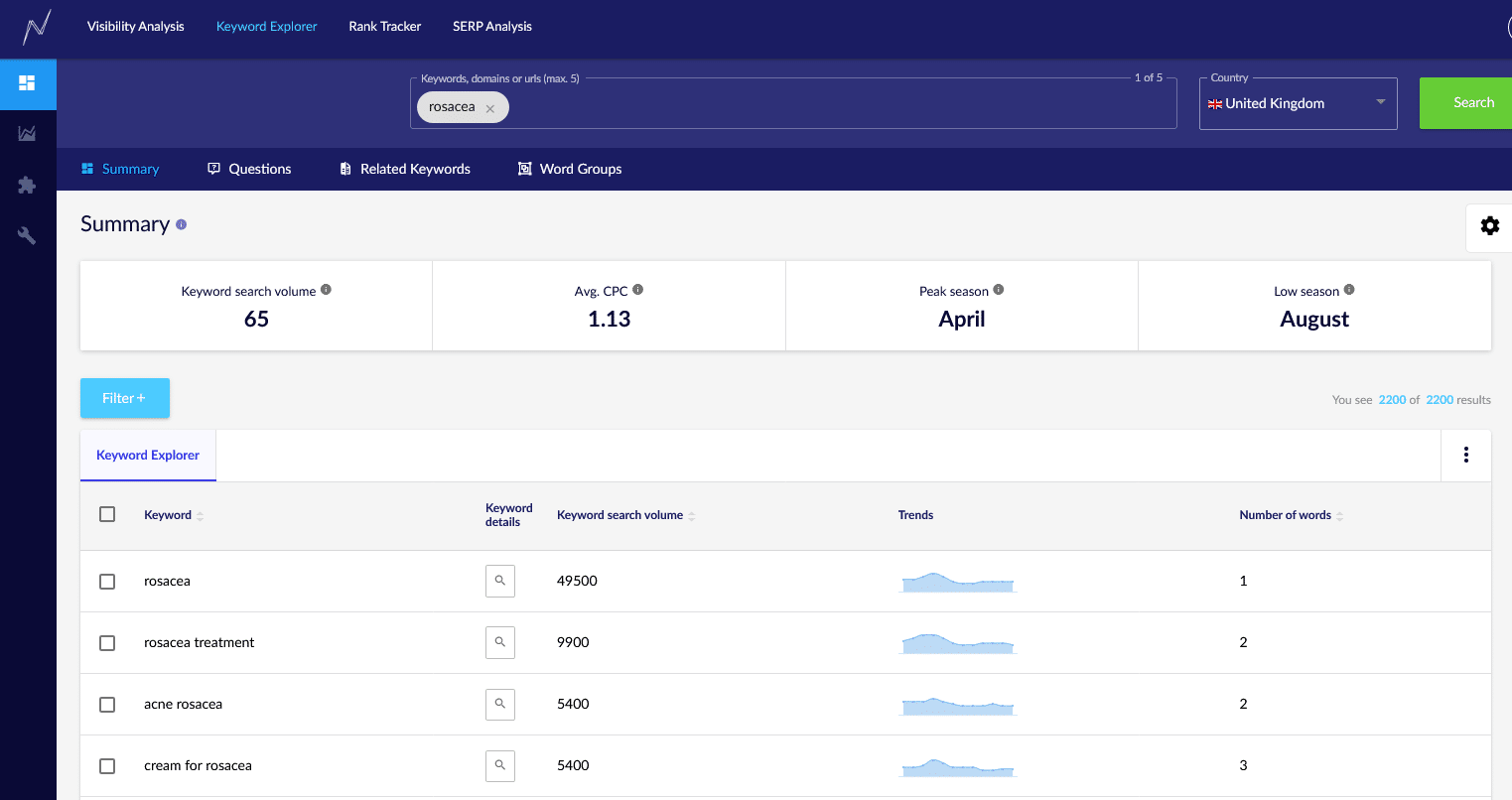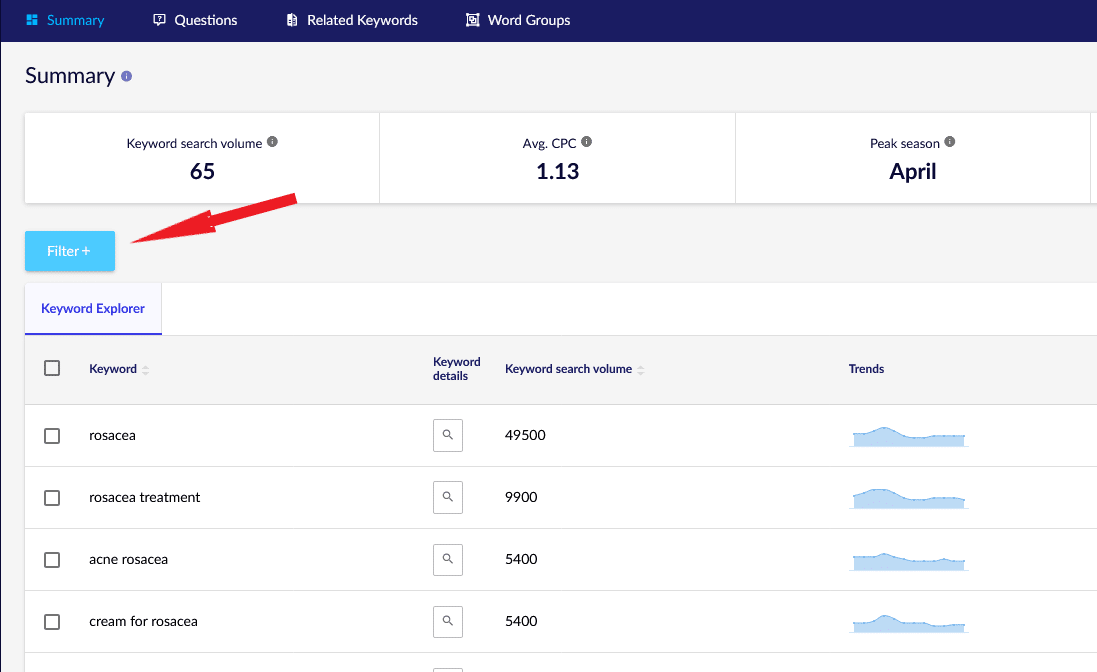Long-tail keywords, made up of several words or even entire clauses, typically get lower search volumes than generic (shorter, general) terms. Yet, they make for a sweet loot in SEO. The long tail is “juicy” and impactful, so it tends to drive far more valuable traffic to your website.
Simply put: people who enter long-tail queries into the search engine know what they want. They have a very specific search intent in mind. This means that the long tail brings you new, motivated, and informed visitors who are already past the generic search phase – pure gold for any website.
However, contrary to popular belief, long-tail SEO doesn’t always boost the conversion rate of an ecommerce business or a content website. As it oft long-tail SEO doesn’t always boost the conversion rate of an ecommerce business or a content websiteen happens in SEO, the devil is in the details. Hence, this guide doesn’t stop at discussing the long-tail strategy, but goes into long-tail marketing and keyword research for long-tail SEO.
1. A long-tail keyword – meaning what?
In a wayward spin, let me introduce you to the world of long-tail keywords by presenting the other side of the coin – the generic phrases (or the so-called “fat head” generating approximately 18.5% of all traffic). Learning about those is a simple way to appreciate the value of long-tail SEO.
- Generic keywords tell you nothing about user intent. They may indicate the start of a customer journey, but not necessarily so. In most cases, one- or two-word phrases come from users who just want to get the lay of the land. If you rank for these head terms, your traffic will explode – but your bounce rate will probably follow suit. Worse yet, generic keywords have sky-high difficulty ratings and take ages to target (a successful campaign may continue for more than a year).
- Let’s move to the chunky middle, a region located a bit farther towards the long tail and generating around 11.5% of the traffic. Typically, chunky middle keywords have 3 words. Their search intent is more explicit, though still a bit off from our desired level of precision. That being said, these terms can successfully generate micro-conversions (such as newsletter signups). They’re also easier to target than the fat head.
- Finally, we get to the long-tail keywords, which account for a whopping 70% of the traffic. They usually contain 4–5 words (or more) and come from users more likely to visit a site that responds to their specific needs. It’s the audience that rarely generates empty traffic – these people know what they are looking for, so they tend to exhibit our intended user behavior.
A word of caution: not every long-tail query comes from a user on a customer journey. In many cases, long-tail queries indicate nothing but deeper dives on the quest for knowledge.
A sample customer journey:
- “rosacea” – around 50 thousand monthly searches, a generic phrase, the user is looking for general information about the disease;

- “is rosacea contagious” – around 170 monthly searches, a long-tail keyword indicating the intent to expand knowledge. It’s a clarification of the generic phrase, unlikely to lead to a sale of any service or product;
- “good dermatologist London” – around 10 monthly searches, a long-tail keyword entered at a point far closer to the purchase decision. Better yet, the user is asking about the service at a specific location – having learned the basics, they’re looking for an expert to fill in the shoes of Dr. Google.
2. Long-tail SEO – a how-to guide
Now that you know the general concept of the long tail, let me show you some examples of long-tail SEO. Let’s say you’re running an electronics store with a small mobile phone section. At your level, you’ll have a hard time competing against the e-commerce giants with their 1000-page websites and formidable backlink profiles. To make matters worse, large chain stores like to target and seize branded traffic. And on top of all that, you need to deal with the rest of contenders jostling through the crowd in the SERPs (search engine results pages): sites for geeks (with guides such as “Top 5 Phones in 2021”) and other electronics stores.
As things stand, there’s no point fighting for general keywords such as “mobile phone” (with a monthly search volume of around 90.5 thousand queries), “Samsung phones” (around 49.5 thousand monthly searches), or even “best mobile phones” (around 9.9 thousand monthly searches).
The path of local SEO may also prove problematic. It involves targeting queries entered by users from the same city or even city district, which is a viable solution for restaurants, lawyers, or doctors (those who see patients in the office – think dentists). But you need something different, unless of course you’re also providing repair services at a brick-and-mortar venue.
You’re left with one option on the table. Take aim for long-tail keywords such as:
- which phone has the best camera (around 1.3 thousand monthly searches)
- what is the most reliable phone (90)
- cheap mobile phones to buy (720)
- which mobile phone is best for business use (50)
- what is the best phone for under 200 pounds (70)
- what is the best phone for battery life (50)
- samsung galaxy a50 blue (10)
3. Long tail in e-commerce
The examples above indicate different types of purchase intent. We can class them into subgroups of long-tail keywords for ecommerce businesses:
- Product-based long-tail keywords (“samsung galaxy a50 blue”) – the backbone of keyword sets for e-commerce. These terms are entered in the search of specific products, models, and often even serial numbers or EANs (European Article Numbers).
- Local long-tail keywords (“good dermatologist London”) – frequently a guarantee of juicy, high-quality traffic. As an added bonus, they tend to reveal the need to visit a physical venue.
- Informational long-tail keywords (“which mobile phone is best for business use”) – typically, the search intent here is not only to expand knowledge but also to get a shopping inspiration. Consequently, with sound content marketing in place, the website should point the user from rankings and inspirational articles to specific solutions, products, and offers.
Some product-based keywords may also reveal the intent to expand knowledge. Take: “samsung galaxy a50 manual” – even though the query names a specific model, it indicates the need for relevant instructions. With that in mind, use your ecommerce product pages for cross-selling. A cross-selling offer can lead to a conversion even if the visitor came for a smartphone manual. (Maybe they use the opportunity to buy a phone case that gets rave reviews and fits their model like a glove? Maybe they’ll fancy a glass protector or a fitband from the same manufacturer?)
4. Merits of long-tail SEO
The long-tail approach brings you more than just impactful, high-quality traffic. Look at the 6 greatest merits of long-tail SEO:
First: you gain a steady traffic source. Long-tail SEO is guaranteed to slowly but surely upscale your traffic for carefully selected keywords that sell. In contrast, targeting generic phrases may often get you a tremendous traffic boost (which looks amazing in a case study on your gains and the progress made by your SEO agency) but also a sudden drop (emergent once the SEO agency has vanished from the horizon). Any algorithm update may deal a blow to your visibility for a handful of general phrases. If these are the cart-horses pulling your entire website, you may find yourself out of sources of new users overnight. Long-tail SEO should protect you from such sharp and bitter twists.
Secondly: you respond to specific needs. Users develop a positive image of the brands that always have a solution to their problem (once the users are past the research phase and feel ready to take the plunge, of course). With that in mind, I often speak of long-tail marketing rather than long-tail SEO, because the concept extends to building your brand and visibility as well.
Third: you’re smart about website architecture development. A long-tail strategy automatically fills your site with diverse article titles and an entire thematic network following the top-down (general-to-specific) approach. That’s the formula for a sound long-tail strategy: start with content targeting the long-tail keywords, and then link from the long tail to the fat head. Just by doing keyword research on the long tail, you’ll get the bulk of your content plan, together with tons of ideas for blog posts or product card content.
Fourth: you build topical authority. A large pool of content that addresses a wide range of needs, even those less popular, and comes complete with internal linking, general guides, and backlinks, is the best recipe for topical authority development. In other words, it’s the way to convince the bots about your expert status, while simultaneously providing practical solutions to your users (who enter your website and stay to make the purchase or just get the most of the session, instead of going back to the search results).
Fifth: higher CTR from the SERPs. Senuto ran a study on the CTR (click-through rate) in SEO. Our conclusions: the shorter the keyword, the lower the CTR (the number of clicks on the listing) and the more snippets in the search results. Specific long-tail keywords generate conversions at Google level, which means they encourage users to visit your site.
Sixth: voice search SEO. By their very nature, long-tail keywords go hand in hand with voice search queries, which typically contain many words and indicate concrete needs. Opt for the long-tail approach, and you’ll automatically target keywords entered with the help of Google Assistant, Siri, or other similar solutions which have been gaining ground across the world.
5. How to find long-tail keywords
There’re a few ways to research long-tail keywords.
- Use free and paid tools
Long-tail keyword suggestions are available in free tools. However, you’ll discover that most of those have some limitations (for instance: they provide suggestions of long-tail keywords and phrases containing a given query, but without search volumes, difficulty ratings, or trends, which are only available in the paid version).
In Senuto, it’s always a good idea to check the details of your target keyphrase – the tool will display related keywords, questions, word groups, and a chart exploring the seasonal trends. Besides, upon entering the main keyword in Senuto, you can always use filters. For instance, first narrow down your list to keywords made up of >4 words, and then limit it further to phrases containing specific word parts (adjectives, verbs, nouns).

- Check related searches and Google autocompletions.
As you’re typing a generic phrase into Google Search, the tool often displays a list of related common long-tail keywords. Besides, at the bottom of the search results page, you’ll find examples of related searches. In many cases, these suggestions are ready-to-use topics for long-tail articles or paragraphs.
- Analyze your competition
As I often say, the best analytical tool you’ve got is your competition. Keep close tabs on the SEO of your rivals and scrutinize their best pages. Delve deep into their visibility analysis. For instance: visibility data for the first search result for the keyword “best mobile phone” may provide tons of related long-tail keywords which the website is also ranking for. Choose some of those and target them with your new articles. The algorithm will appreciate the effort. As a result, you may end up stealing some of your rival’s traffic.
Hint: Senuto Keyword Explorer can filter results by domains – it’s a useful feature when you have specific market benchmarks to outperform in the search results.
- Browse online discussion forums
The most laborious method of all – a journey to the source. An exploration of online forums may bring you a cornucopia of topic ideas for long-tail marketing, especially if you focus on popular threads and articles attracting hundreds of comments.
Better yet, when doing your research, you can post a link to a ready-to-use guide or an exhaustive product description – as a solution to the needs raised by other users. Admittedly, links published on message boards usually have a “nofollow” attribute, so they won’t bolster your link profile. Still, a link in the right place may drive high-quality traffic to your website.
6. Semantic expansion of long-tail keywords
Have you already got a content plan and a list of long-tail keywords likely to generate conversions? Nice! Now expand each of those keywords with a list of semantically related phrases. Combining several – or several dozens – of long-tail keywords in a single article or product card gives you a credibility boost.
To generate a list of semantically related keywords, go to the Related Keywords tab in Senuto. Make sure to apply filters. For instance, enter: “a mountain bike” (the main keyword), then sieve through the results with the filter: “contains the word: cheap”, and finally sort the results by their average monthly search volume.
7. Tracking the effects of long-tail SEO
If you’re trying to boost your ranks for a few long-tail keywords, the matter is simple. You can track progress in the search results (using the incognito mode in the browser), Google Analytics (checking traffic for particular articles or products), and Google Search Console (Performance report -> Queries).
However, when doing long-tail SEO for hundreds or thousands of phrases, what you need is automation. It can be done with the Senuto Rank Tracker.
The tool will measure the performance of your project, analyze your visibility shifts for the targeted long-tail keywords, and keep an eye on the keyword rankings of your chosen competitors.
 Jacek Krajl
Jacek Krajl